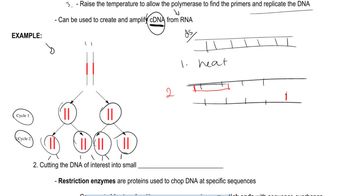Table of contents
- 1. Introduction to Genetics51m
- 2. Mendel's Laws of Inheritance3h 37m
- 3. Extensions to Mendelian Inheritance2h 41m
- 4. Genetic Mapping and Linkage2h 28m
- 5. Genetics of Bacteria and Viruses1h 21m
- 6. Chromosomal Variation1h 48m
- 7. DNA and Chromosome Structure56m
- 8. DNA Replication1h 10m
- 9. Mitosis and Meiosis1h 34m
- 10. Transcription1h 0m
- 11. Translation58m
- 12. Gene Regulation in Prokaryotes1h 19m
- 13. Gene Regulation in Eukaryotes44m
- 14. Genetic Control of Development44m
- 15. Genomes and Genomics1h 50m
- 16. Transposable Elements47m
- 17. Mutation, Repair, and Recombination1h 6m
- 18. Molecular Genetic Tools19m
- 19. Cancer Genetics29m
- 20. Quantitative Genetics1h 26m
- 21. Population Genetics50m
- 22. Evolutionary Genetics29m
18. Molecular Genetic Tools
Genetic Cloning
Problem 3b
Textbook Question
Why are most recombinant human proteins produced in animal or plant hosts instead of bacterial host cells?
 Verified step by step guidance
Verified step by step guidance1
<span>Identify the key differences between prokaryotic (bacterial) and eukaryotic (animal or plant) cells, focusing on their cellular machinery and post-translational modifications.</span>
<span>Understand that eukaryotic cells have the necessary cellular machinery to perform complex post-translational modifications, such as glycosylation, which are often required for the proper function of human proteins.</span>
<span>Recognize that bacterial cells lack the ability to perform these complex modifications, which can lead to improperly folded or non-functional proteins when human proteins are expressed in bacterial hosts.</span>
<span>Consider the potential for immunogenicity, where proteins produced in bacterial cells might be recognized as foreign by the human immune system due to differences in folding or modifications.</span>
<span>Evaluate the advantages of using animal or plant hosts, such as the ability to produce proteins that are more similar to their natural human counterparts, reducing the risk of immune reactions and increasing therapeutic efficacy.</span>
Recommended similar problem, with video answer:
 Verified Solution
Verified SolutionThis video solution was recommended by our tutors as helpful for the problem above
Video duration:
1mPlay a video:
Was this helpful?
Key Concepts
Here are the essential concepts you must grasp in order to answer the question correctly.
Post-Translational Modifications
Recombinant proteins often require specific post-translational modifications, such as glycosylation, phosphorylation, and proper folding, to function correctly. Animal and plant cells have the necessary cellular machinery to perform these modifications, which are often absent or insufficient in bacterial systems, leading to improperly folded or inactive proteins.
Recommended video:
Guided course

Post Translational Modifications
Protein Folding and Assembly
The correct folding and assembly of proteins are crucial for their biological activity. Eukaryotic cells, such as those from animals and plants, provide a more complex environment that supports proper protein folding and assembly, while bacterial cells may lead to the formation of inclusion bodies, where proteins aggregate and lose functionality.
Recommended video:
Guided course

Proteins
Protein Yield and Secretion
Eukaryotic systems, including animal and plant hosts, often allow for higher yields of functional recombinant proteins and can secrete them into the culture medium. This is advantageous for purification processes, as it simplifies the recovery of the desired protein, unlike bacterial systems where proteins may remain intracellular or require additional steps for extraction.
Recommended video:
Guided course

Proteins

 7:43m
7:43mWatch next
Master Genetic Cloning with a bite sized video explanation from Kylia Goodner
Start learningRelated Videos
Related Practice


